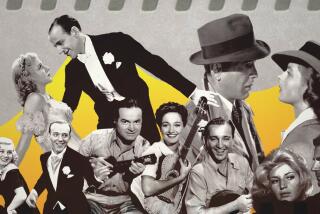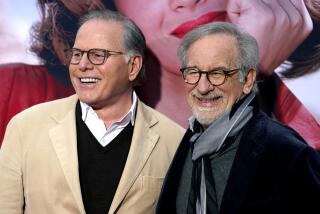The ‘Tron’ Dilemma: A Movie Born Too Soon
Dolphin guru John Lilly likened the film to “cosmic game-playing.” The editor of a psychoanalytical journal interpreted its real world/electronic world duality as “the filmic conceptualization of schizophrenia.” And Vice President Al Gore, no doubt entranced by its pre-Information Superhighway perspective, ranks it as his favorite movie of all time.
The film in question is Disney’s 1982 “Tron,” a high-tech odyssey starring Jeff Bridges and Bruce Boxleitner as gladiators battling an evil programmer inside a world of game grids and a Tinkerbell-inspired bit. “Tron” released in the formidable wake of “E.T.” promptly faded from the box office.
Today debate over the film’s importance rages on. “Tron” is recalled both as the pioneering effort in computer graphics imaging and a $17-million boondoggle that set the cause back 13 years--until “Toy Story” arrived on the scene.
And while today’s CGI experts, at Sunnyvale’s Pacific Data Images and George Lucas’ Industrial Light & Magic in Marin County, acknowledge the groundbreaking efforts of “Tron’s” writer-director Steven Lisberger--the erstwhile boy wonder charged with rescuing Disney from box-office doldrums in the early ‘80s--they remain divided on whether he’s a charlatan or a visionary.
“ ‘Tron’ pushed the envelope of what was available at the time--and for that it deserves credit,” says Carl Rosendahl, founder and CEO of PDI, now at work on DreamWorks’ computer-animated “Antz” (due spring 1999). “We all went to see it the day it opened. At the time it looked cool, but it hasn’t held up at all; it hasn’t had the impact of ‘Toy Story’ and ‘Jurassic Park.’ ”
“Too insider [and] hard to follow” is how ILM effects supervisor Stefan Fangmeier describes “Tron.” Fangmeier, who oversaw computer effects on “Twister” and this summer’s upcoming “Saving Private Ryan,” adds: “It was ahead of its time conceptually, being inside a computer, but the story appealed to a small video-game culture, which had not matured to the global acceptance of today. That was its downfall.”
Surf the Web and you come away with another impression: It wouldn’t be exaggerating to say the film’s more ardent defenders verge on the evangelistic. Over the years, a cult has grown up around the Disney epic, just restored in all its 70mm glory on widescreen DVD (with Wendy Carlos’ electronic music now in Dolby 5.1 and the original trailer promising viewers “a startling new world.”).
What does Lisberger make of this? Depends on when you ask him. Some days he wishes it would all go away and the “Tron”-ites would get a life. Other days, he’s amazed by his creation’s continued hold on the collective subconscious.
Charlatan or visionary? Lisberger himself isn’t sure.
“Think of me as Obi-Wan Kenobi,” says the filmmaker, who lives in Santa Monica with his wife, Peggy, and 12-year-old son, Carl. “Someday, an R2D2 unit is going to show up with the plans to the Deathstar and ask for my help.”
He pauses, then adds wearily: “Nineteen-eighty-one was a long time ago in media years.”
While “Tron” was looked upon as risky and, avant-garde in its day (Bridges said he came aboard because it was “innovative . . . something new”), Lisberger’s parallel universe of grids and light-cycles pointed the way for the next generation CGI movies, such as “Jurassic Park,” “The Mask,” “Forrest Gump” and, of course, “Titanic.”
“I’m 47 years old, but sometimes I feel like Moses,” says Lisberger, who, in recent months, has been struggling with “some health issues” (diagnosed as neuropathy). “I’m sort of a recluse. I’ve fallen behind the curve in technology. It’s ironic that everybody else is into [CGI] and I’m not now.”
Lisberger has chosen to reemerge now, he says, because he wants to set the record straight on “Tron” and, for the first time since his straight-to-video “Slipstream” (1985), return to directing. “I’ve got a shelf full of stuff that I’m trying to get off the ground, and friends are pushing me to make something happen again.”
Among the projects he’s considering: “Sleepy Head,” described as a voyage into son Carl’s mind; “First,” a biopic about the Wright brothers developed for Francis Ford Coppola; “Hiawatha,” an animated feature optioned by Warner Bros., and “Sorcerer’s Apprentice,” a live-action fantasy for Trimark Pictures. When he isn’t writing, Lisberger trouble-shoots for computer graphics companies, such as Rainbow Studios in Arizona, now at work on an underwater adventure called “Blue.”
While not big on effects-driven cyber-movies, Lisberger is pleased by the success of “Titanic,” which he calls “a watershed film” in its ability to fuse cutting-edge technology and old-fashioned storytelling. In some ways, Lisberger says, James Cameron’s triumph feels like vindication for his own post-”Tron” letdown.
“But I’m looking less for vindication now than I used to,” he says. “My vindication comes on a more personal level . . . running into Gen Xers and hearing how much the picture meant to them. The stigma of that other stuff is finally fading.”
The “other stuff” includes the long-held belief that “Tron” was a financial disaster. In fact, the film roughly paid for itself, Lisberger says (and Disney corroborates), grossing $34 million domestically, $20 million overseas and, he estimates, another $20 million in video-game merchandising.
“ ‘Tron,’ ” Lisberger says flatly, “only failed in terms of Disney’s false expectations.”
Tom Wilhite, head of production at Disney between 1979 and 1984, recalls Disney being “very much behind the picture” as the company tried to expand its audience with more adult fare like “Tron” and “Splash.”
“You have to remember Disney was a different company than it is today,” adds Wilhite, now president of Hyperion Animation in Glendale. “Parks and merchandising were its primary business.”
“Tron” opened in July 1982--the same summer as a sentimental boy-and-his-alien parable called “E.T.” Disney management, rocked by what was essentially a live-action “Peter Pan,” compared its weekly grosses to Universal Pictures’ and wasn’t amused.
But Disney badly miscalculated the long-range impact of “Tron,” Lisberger maintains. “They didn’t understand where the value was. Its value to the studio was as a ground-breaking, experimental film that attracted creative people.”
For Lisberger, the grid world of the computer was not so much a technical marvel as “a Rorschach test, an impressionistic symbol of our subconscious. . . . I’ve never been a computer person, as such. I see myself more as a guide between places. I’m intrigued by other worlds, other realms.”
Filmgoers, however, not surprisingly found “Tron” difficult to track. Lisberger believes they “were rattled by the vocabulary--bits and bytes and programs. All the stuff that’s become the vernacular.”
In the years since, movies like “Toy Story” have gained wide acceptance and may have even paved the way for a “Tron” sequel. At least that’s what wishful thinkers on the Internet are hoping, although Lisberger says there has been no push on the part of Disney, which holds the rights. (“There are no discussions that I’m aware of at this time of a ‘Tron’ sequel,” says a representative of Buena Vista Home Video.)
Still, Lisberger wouldn’t object to a second chance. “Maybe someday,” he says, “a light bulb will go off over a young executive’s head.”
More to Read
The biggest entertainment stories
Get our big stories about Hollywood, film, television, music, arts, culture and more right in your inbox as soon as they publish.
You may occasionally receive promotional content from the Los Angeles Times.










